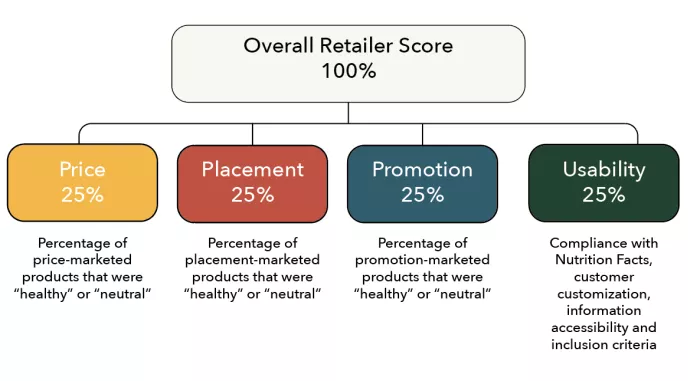
Online Grocery Marketing Scorecard
Three-quarters of Americans’ calories come from food retailers, making grocery stores and the retail food environment key contributors to the diets and health of Americans. As grocery shopping becomes more digitized, online food environments are becoming just as critical for improving food access and prioritizing healthy food marketing.
Yet, research examining online food marketing practices is limited. To address this gap, the Center for Science in the Public Interest (CSPI) developed the Online Grocery Marketing Scorecard to assess the online food retail environments at 11 top revenue-generating online food retailers in the U.S on healthy food marketing and website usability.
Scorecard categories
Our study scored and ranked these retailers with respect to the following four dimensions:
Methodology
We evaluated retailers by conducting online shopping simulations to reflect a typical customer’s experience, collecting nutrition information on marketed items along the way. We also assessed each website’s usability features. Check out our video to learn more:
How we scored retailers: The maximum overall retailer score is 100, with each category equally weighted at 25%. Marketing scores reflect the percentage of products marketed as healthy or neutral, while usability scores are based on the percentage of criteria met.

Key Research Findings
Overall, the online retail food environments at the top 11 revenue generating U.S. online grocery retailers each received a score 72% or lower.
This indicates poor performance with respect to pricing, placement, and promotion of healthier products, and poor usability of the retailers’ websites. Retailers scored highest on website usability (Median: 72%), followed by placement (Median: 59%), promotion (Median: 56%) and price (Median: 56%).
Most marketing (72%) in the online retail food environment is for food and beverages that are not healthy.
72% of products marketed through price reductions, 71% of products marketed through placement strategies, and 73% of products marketed through promotion strategies were not healthy.
There are many opportunities for retailers to improve the usability of the online food shopping experience.
With all retailers scoring 76% or lower in our assessment’s usability category, there is much room for improvement in retailer website usability to make online grocery shopping accessible for all consumers, including people with disabilities, people with dietary restrictions or preferences, and people who participate in nutrition assistance programs. For example, retailers could more clearly and consistently label products, reduce delivery fees, and follow Web Content Accessibility Guidelines.

